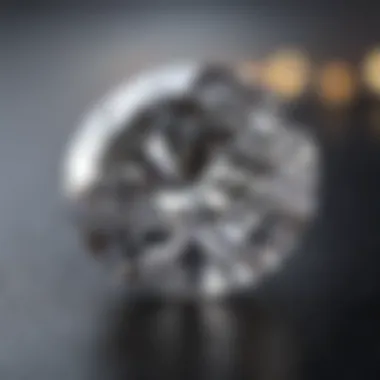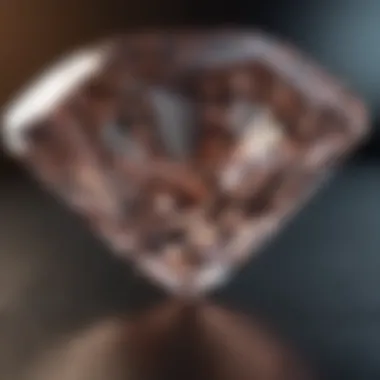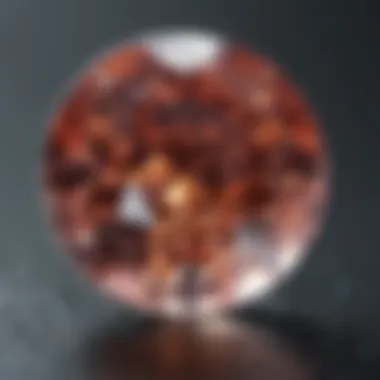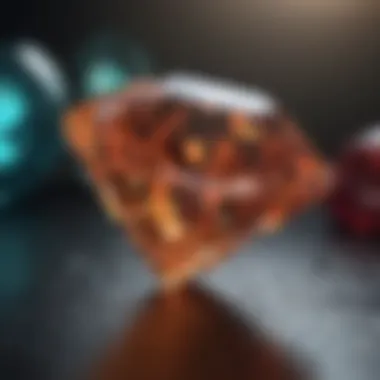Understanding SI Quality Diamond Pricing


Intro
The gemstone market is complex and intricate, intertwining various factors that affect the value of stones, specifically SI quality diamonds. Understanding this market not only helps potential buyers make informed choices but also aids collectors and professionals in navigating their investments.
This article will delve deeply into the elements influencing SI quality diamond pricing. By examining the unique attributes that define SI quality diamonds and the pricing frameworks established by jewelers, we aim to provide clarity to individuals seeking to engage with this sector.
In the following sections, we will explore market trends, look into the characteristics of SI quality diamonds, and highlight important considerations relevant to buyers.
Gemstone Overview
Definition and Characteristics
Diamonds are a form of carbon that has been subjected to extreme pressure and temperature beneath the Earth's surface. SI quality diamonds, known for their specific clarity characteristics, fall within the Slightly Included range of clarity grading. This classification means they contain some inclusions that are visible under magnification but are not typically noticeable to the naked eye.
Key characteristics of SI quality diamonds include:
- Clarity: The presence of minor inclusions that do not significantly affect appearance.
- Cut: The way a diamond is fashioned can affect its brilliance and overall attractiveness.
- Color: SI diamonds often range from colorless to near colorless, contributing to their market value.
- Carat Weight: This is a direct measurement of the diamond's size, influencing its price.
Classification of Gemstones
Gemstones can be broadly classified into two categories: precious and semi-precious. Diamonds are viewed as precious gemstones, highly valued due to their rarity and unique qualities. In the context of diamonds, SI quality represents a significant segment that appeals to buyers looking for quality at a more accessible price point compared to higher clarity grades like VVS or IF.
Understanding this classification aids in comprehending the placement of SI diamonds within the broader gemstone market.
Historical Significance
Ancient Uses and Cultural Importance
Throughout history, gemstones have been treasured for their beauty and perceived powers. In ancient cultures, diamonds were thought to possess properties of strength and purity. They were often used in crowns and ornaments of nobility, reflective of status and power.
SI quality diamonds, although less visible in historical records than their clearer counterparts, still hold significance as practical choices for adornment, showcasing blend of beauty and value.
Myths and Legends Surrounding Gemstones
The allure of gemstones is also tied to myths and legends. Diamonds are often associated with love, commitment, and eternal bonds, largely due to their hardness and durability. Across various cultures, they symbolize not just beauty but also strength and resilience. Such associations play a role in how these gemstones are marketed and perceived in contemporary society.
However, the focus on SI quality diamonds opens up a narrative of accessibility and practicality, moving beyond simply the high-end luxury often associated with the gemstone market.
"Understanding the historical context of diamonds can provide a broader perspective on their current market value and appeal."
With this foundation, we shall delve further into the pricing mechanisms and market trends associated with SI quality diamonds in the next sections.
Intro to Diamond Grading
Understanding diamond grading is crucial when it comes to evaluating the value of diamonds, especially SI quality diamonds. Grading is not just a method of appraising a diamond's physical characteristics; it represents a standardized approach that informs buyers about what they are purchasing. In the context of this article, the focus on diamond grading is intended to help potential buyers and investors make informed decisions.
Diamond grading involves a detailed examination of various attributes that contribute to a diamond's overall quality and market price. This process is vital for establishing trust between buyers and sellers. With a firm grasp on grading, collectors, jewelry designers, and geology enthusiasts can navigate the market with greater confidence, ensuring they are making sound investments.
Key elements of diamond grading include its impact on resale value and how it influences buyer sentiment. A clear understanding of these elements helps prevent common pitfalls, such as overpaying for a diamond or misjudging its quality. Therefore, diving into the fundamentals is not merely an academic exercise; it has real-world implications for anyone involved in the diamond trade.
This section will lay the groundwork for understanding the characteristics that differentiate SI quality diamonds from their peers. Each feature, from clarity to cut, offers insight into pricing and desirability. Thus, comprehending the intricacies of diamond grading becomes an essential step towards effective decision-making.
Understanding the Cs of Diamonds


The term "4 Cs" refers to the four essential characteristics used to evaluate diamonds: Carat, Cut, Color, and Clarity. Each characteristic plays a significant role in determining a diamond's quality and, consequently, its pricing.
- Carat: This refers to the weight of the diamond. Diamonds are weighed in carats, with one carat equivalent to 0.2 grams. Larger diamonds are rarer and usually more expensive, but carat weight isn't the sole factor in pricing.
- Cut: The cut of a diamond relates to how well it has been shaped and faceted, affecting its brilliance and sparkle. Excellent cuts reflect light beautifully, while poorly cut diamonds may look dull or lose light.
- Color: Diamond color ranges from colorless to light yellow or brown. The less color present, the more valuable the diamond. However, fancy color diamonds, which have vivid shades, can also command high prices.
- Clarity: This characteristic assesses the presence of inclusions or blemishes. Clarity is graded on a scale from Flawless to Included, affecting both the diamond's beauty and value.
Understanding these components is critical for anyone interested in purchasing or investing in SI quality diamonds. While each of the 4 Cs contributes to a diamond’s overall value, clarity holds particular significance in the context of SI quality.
What is SI Quality?
SI quality diamonds, or "Slightly Included" diamonds, fall into a specific category within the clarity grading system. They contain inclusions that are visible under 10x magnification but often imperceptible to the naked eye. This means buyers can acquire diamonds of considerable size and beauty at a more accessible price point compared to higher clarity ratings.
The appeal of SI quality lies in its balance between quality and affordability. These diamonds can provide significant value for those who appreciate their inherent beauty without the need to invest in higher clarity options, which may be out of budget.
While selecting SI quality diamonds, buyers should consider the location, size, and type of inclusions, as these factors can influence visual appearance and, ultimately, price. For many collectors and enthusiasts, SI quality diamonds offer an opportunity to invest in striking pieces without excessive expenditure.
The Characteristics of SI Quality Diamonds
Understanding the characteristics of SI quality diamonds is paramount for buyers and enthusiasts alike. These characteristics significantly impact the diamond's value, appearance, and overall desirability. SI, shorthand for Slightly Included, diamonds may showcase some inclusions visible under magnification. However, they typically offer an attractive balance between price and quality, making them an appealing choice for many consumers. In this section, we delve into the specific elements that define SI quality diamonds, including clarity, color grading, and cut quality.
Clarity and Its Implications
Clarity refers to the presence of internal or external flaws within a diamond. SI quality diamonds exhibit minor inclusions that are not immediately visible to the naked eye. Understanding clarity is crucial because it influences the diamond's aesthetic appeal and perceived value.
- Types of Inclusions: Inclusions can be crystal, feather, or cloud. These varied types play a role in how light interacts with the diamond, affecting brightness and sparkle.
- Grading Implications: The GIA (Gemological Institute of America) provides a clarity scale which helps buyers understand what to expect in an SI diamond. Knowing this scale guides decision-making when selecting a stone.
- Consumer Perspective: SI diamonds tend to have a more accessible pricing structure compared to higher clarity grades, allowing buyers to acquire larger stones without a significant premium.
In summary, clarity is integral to both the appearance and market value of SI diamonds. Buyers should examine this feature carefully before making a purchase.
Color Grades in SI Diamonds
The color grade of a diamond indicates how colorless the stone appears. The GIA color scale ranges from D (colorless) to Z (light yellow). For SI quality diamonds, the color grade can impact the diamond's desirability and price.
- Importance of Color: Colorless stones tend to fetch higher prices. Meanwhile, SI diamonds often range from G to J on the scale, providing a favorable balance between color and cost.
- Visual Impact: Slight variations in color can be subtle yet impactful. A high-quality SI diamond with a G color grade can appear visually similar to a higher-grade D stone, making it a wise choice for those who prioritize value alongside beauty.
- Market Trends: Trends also shift based on fashion preferences. For instance, some buyers may actively seek slightly warmer colors for a unique aesthetic, influencing pricing dynamics in the market.
Understanding the role of color grading allows buyers to make informed decisions when selecting an SI diamond.
Cut Quality and Its Influence on Price
The cut of a diamond dictates how well it reflects light, significantly affecting its brilliance and overall appearance. Cut quality not only influences aesthetic appeal but also has a direct correlation to the stone's price.
- Cut Grades: The cut grades range from Excellent to Poor. An excellent cut optimizes light performance, ensuring maximum sparkle. On the other hand, a poor cut can diminish even the most visually appealing stone.
- Price Influence: SI diamonds with superior cut quality command higher prices due to their enhanced beauty. Buyers should seek diamonds with excellent or very good cut grades to ensure they are investing in quality.
- Market Preferences: Jewelers and buyers alike prioritize cutting standards since the brilliance achieved through proper cut not only enhances the stone itself but also elevates the overall jewelry piece.
Market Trends in Diamond Pricing
Understanding the market trends in diamond pricing is crucial for anyone interested in SI quality diamonds. This knowledge provides insights into how diamonds are valued and the various external factors that impact their prices. Historical context, current supply and demand dynamics, and the effects of global events all contribute to forming a comprehensive view of the diamond market. These factors not only influence the pricing but also highlight potential investment opportunities and risks.
Historical Price Fluctuations
Price fluctuations of diamonds over time tell a story about consumer trends and economic conditions. In the past, diamond prices have experienced periodic increases and declines. Various factors—including economic recessions, inflation, and changes in consumer preferences—play a significant role in these trends. For instance, during economic downturns, luxury items like diamonds may see a decline in demand, leading to a fall in prices. However, when economies prosper, demand often increases, driving prices up.
"Historical data shows that diamond prices can be volatile, yet they often trend upwards over long periods."
Factors such as changes in mining outputs also impact historical pricing. Major discoveries, like those in Botswana or Russia, have introduced new supplies, affecting the market. Similarly, the introduction of synthetic diamonds has raised questions and concerns about value in the traditional diamond market.
Current Demand and Supply Dynamics


Today, the dynamics of supply and demand are influenced by various elements including population growth, changes in purchasing power, and evolving consumer tastes. The rise of online shopping has made diamonds accessible to a broader audience. This shift alters not only how diamonds are marketed but also who can buy them.
In addition, the demand for ethically sourced diamonds has changed the landscape significantly. Consumers are increasingly seeking transparency in mining practices, which influences their purchasing decisions. As a result, the supply chain now emphasizes sustainability, creating new price structures for SI quality diamonds. Retailers often charge a premium for diamonds that come with assurance of ethical sourcing, thereby affecting overall market pricing.
Impact of Global Events on Pricing
Global events have far-reaching effects on diamond pricing. Economic shifts, trade policies, and geopolitical conflicts can create an atmosphere of uncertainty. For instance, trade wars might lead to increased tariffs on diamonds, consequently raising retail prices for consumers.
Natural disasters also pose a significant risk. For example, if key mining areas are affected by disasters or political unrest, this can disrupt the supply chain, leading to price hikes. Additionally, events like the pandemic have demonstrated how quickly demand can change. During lockdowns, the demand for luxury items—including diamonds—plummeted, reflecting a stark impact on pricing. As markets recover, trends may indicate a rebound in demand, thus pushing prices up again.
Factors Influencing SI Diamond Prices
In the realm of SI quality diamonds, understanding the factors that influence pricing is critical for buyers and investors alike. The price of these diamonds does not solely depend on the 4 Cs—clarity, color, cut, and carat weight—but also on other significant aspects, including geological origins, retail dynamics, and the role of certification. These factors help shape the perceived value of the diamond in the market, affecting both personal purchases and investment decisions.
Geological Origins and Mining Sources
Geological origins significantly affect SI diamond prices. Diamonds are not produced equally, and the location from which they originate often holds importance for collectors and investors. For instance, diamonds sourced from well-known regions such as Botswana, Russia, or Canada generally carry a premium due to their reputation for quality and ethical mining practices. On the other hand, diamonds from less recognizable sources may be priced lower, despite having comparable characteristics.
Furthermore, mining methods impact the price as well. Diamonds that are extracted using environmentally sound techniques or those labeled conflict-free often have higher demand among ethically-minded consumers. This demand can drive prices upwards, as buyers are willing to pay more for stones that align with their values.
Retail Markup and the Jewelers' Perspective
When examining SI diamond pricing, one must consider the retail markup that jewelers apply. Retail markup can vary widely among different jewelers and is influenced by factors such as the brand's reputation, store location, and target clientele.
Jewelers often factor in costs beyond the simple acquisition price of the diamond. This includes expenses associated with maintenance of the physical store, marketing, and customer service. As a result, the final retail price can be significantly higher than the diamond's wholesale price.
Key Considerations for Buyers:
- Compare prices from different retailers to ensure competitive pricing.
- Be aware of promotions or discounts which may influence pricing.
Buying directly from a reputable dealer can sometimes help to minimize the retail markup, allowing buyers to secure a better deal on their SI diamonds.
The Role of Certification in Pricing
Certificates are crucial in determining the market value of SI diamonds. A certification from a recognized gemological laboratory acts as a guarantee of the diamond's quality and authenticity. Organizations like the Gemological Institute of America (GIA) or the International Gemological Institute (IGI) produce detailed reports that grade diamonds based on the 4 Cs and other important factors.
A certified SI diamond generally commands a higher price compared to an ungraded diamond. Buyers are willing to invest more when they can confirm the quality and characteristics through reputable grading.
"Certification not only provides assurance regarding quality but also plays a pivotal role in the resale value of the diamond."
Evaluating SI Diamonds in the Market
Evaluating SI diamonds is crucial in understanding their market presence and pricing. This process not only encompasses the assessment of the diamonds' quality but also the evaluation of market conditions, consumer preferences, and the impact of various external factors. The significance of this evaluation cannot be overstated; it lays the groundwork for making informed purchasing decisions, whether for personal adornment or investment strategies.
When evaluating SI diamonds, several key elements come into play. First, buyers must recognize the clarity, cut, color, and carat weight typically associated with SI quality. Each of these characteristics contributes to the overall value and desirability of the diamond. Moreover, understanding market trends helps buyers anticipate price fluctuations and gauge potential returns on investment.
Benefits of evaluating diamonds include:
- Informed Decision-Making: Knowing what to look for ensures that you make choices that align with your quality standards and budget.
- Identifying Value: A thorough evaluation helps differentiate between reasonably priced diamonds and those that may carry an excessive premium.
- Investment Insights: Understanding market dynamics allows buyers to recognize potential opportunities for appreciation in value over time.
In short, evaluating SI diamonds in the market provides a holistic view of their worth, equipping buyers with the necessary insights for successful transactions.
How to Analyze SI Quality Diamonds


Analyzing SI quality diamonds involves a systematic approach. Start by examining their clarity, assessing the types and locations of inclusions or blemishes. Review certifications from recognized organizations like the Gemological Institute of America. Next, consider the color grade, as it significantly impacts pricing. Diamonds in the near-colorless range often retain more value. Assess the cut quality, focusing on how well the diamond reflects light, which enhances its brilliance. Furthermore, factor in the carat weight, as larger diamonds typically command higher prices.
Common Misconceptions about SI Quality
There are prevalent misunderstandings surrounding SI diamonds. One common misconception is that SI quality equals visibly flawed diamonds. In reality, many SI diamonds possess inclusions that are not easily noticed without magnification. Buyers often assume all SI diamonds are inferior in quality, but they can be a cost-effective option for those seeking beauty without the highest price tags. Additionally, the belief that SI quality diamonds lack resale value is misguided; they can still appreciate, especially if well-maintained.
Best Practices for Buying SI Diamonds
Engaging in best practices can enhance the buying experience for SI diamonds. Here are some to consider:
- Research Thoroughly: Educate yourself about characteristics of SI quality diamonds to empower informed decisions.
- Seek Certification: Always choose diamonds that come with certification from reputable gemological organizations.
- Consult Experts: Don’t hesitate to ask jewelers or gemologists for insights; their expertise can guide your choices.
- Compare Prices: Shop around to discern competitive prices for similar quality diamonds.
- Prioritize Personal Preferences: Ultimately, choose a diamond that resonates with your taste and requirements.
By following these best practices, buyers can navigate the market more effectively, ensuring they procure the right SI diamonds that meet their needs, whether for personal use or as an investment.
Investment Considerations for SI Diamonds
When discussing SI quality diamonds, it is essential to address the investment potential they hold. This aspect is crucial for any buyer looking to secure long-term value in their purchase. Investing in SI diamonds can yield significant benefits when approached with a clear understanding of market dynamics and individual needs.
Evaluating Potential Returns
SI quality diamonds, while not the rarest option, have a stability that often attracts investors. To evaluate their potential returns, one must consider several factors:
- Market Demand: The appeal of SI diamonds lies in their affordable pricing compared to higher grades. As more people seek engagement rings and other jewelry, the demand can boost their market value.
- Fluctuation Trends: Analyzing historical price data can provide insights into how SI diamonds have fared over time. Understanding peak and valley prices helps investors anticipate future trends.
- Resale Value: While some buyers purchase SI diamonds for personal enjoyment, others see them as an asset. If you decide to sell in the future, knowing the resale market is critical.
In essence, assessing potential returns involves understanding the balance between initial purchase price and the prospective increase in value over time.
Market Stability and Risks
Investing in SI diamonds does come with considerations of market stability and risks. The diamond market can be influenced by various economic conditions:
- Economic Health: Global economies affect luxury spending. A tightening economy may reduce demand for diamonds, affecting prices. Conversely, in a thriving economic environment, demand typically increases, stabilizing or raising prices.
- Supply Chain Issues: Natural disasters, political unrest in mining regions, and other disruptions can affect supply. If major producers experience issues, prices may increase due to scarcity, or they could drop if stocks become too plentiful.
- Market Speculation: Speculators can drive prices up or down based on trends or hype. Staying informed about market developments is essential for any investor.
Although risks exist, understanding the factors that contribute to market stability allows investors to make more informed decisions.
The Importance of Professional Appraisals
For anyone considering an investment in SI diamonds, obtaining a professional appraisal is vital. Here are key points about why professional appraisals are important:
- Independent Verification: A professional appraiser provides an unbiased evaluation of a diamond’s quality and value. They can confirm that the SI quality designation is accurate.
- Market Comparison: Appraisers have access to extensive market data and can compare your diamond against similar items, helping you understand its value in the current market.
- Insurance Purposes: Having a well-documented appraisal helps in getting proper insurance coverage for the diamond. This is crucial in protecting your investment against theft or damage.
In summary, a professional appraisal not only confirms the diamond’s worth but also equips you with significant insights to safeguard and manage your investment.
Finale
The conclusion of this article draws together the key themes and insights discussed throughout the various sections on SI quality diamond pricing. It emphasizes the intricate nature of diamond valuation, particularly for SI quality diamonds. Understanding these nuances is essential for anyone considering purchasing or investing in diamonds.
Recap of Key Insights
We have explored multiple aspects of SI quality diamonds and their pricing structures. Here is a summary of the main points:
- The 4 Cs: The clarity, cut, color, and carat weight significantly influence the pricing of diamonds. SI quality diamonds exhibit specific characteristics that can affect their market value.
- Market Dynamics: The historical price trends and current supply-demand dynamics play critical roles in shaping diamond prices. Factors like global events and economic conditions also impact market behavior.
- Investment Considerations: Potential returns on SI quality diamonds require careful evaluation, coupled with an understanding of market risks and the necessity for professional appraisals.
These insights provide a solid foundation for informed decision-making regarding SI diamonds.
Future Trends in SI Diamond Pricing
Looking ahead, several trends may shape the future of SI quality diamond pricing:
- Sustainability Demand: As consumers increasingly seek ethically sourced gemstones, the demand for sustainably mined SI diamonds may grow, potentially influencing their prices.
- Innovation in Technology: Advances in diamond grading technology could allow for more precise evaluations. This can lead to better pricing strategies based on individual diamond characteristics.
- Market Expansion: Emerging markets could create new opportunities for SI diamonds, contributing to shifting dynamics in supply and demand.
In summary, recognizing these future trends will be vital for stakeholders in the diamond industry. Comprehensive understanding along with strategic planning can lead to enhanced opportunities in SI diamond investments.







